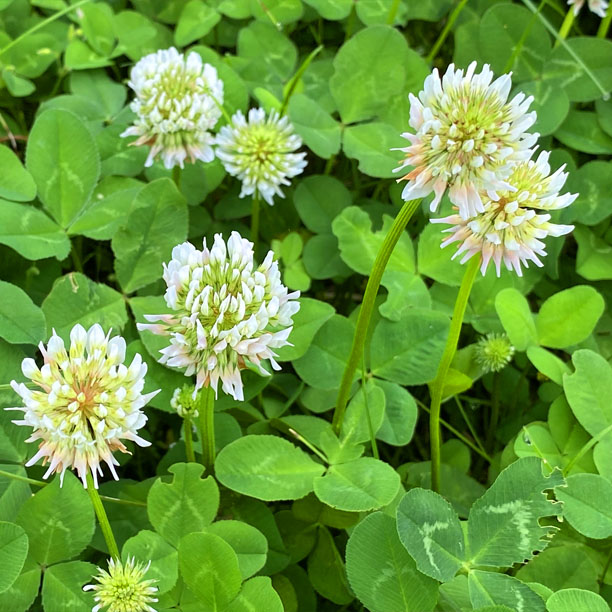White Clover
How To Identify
White clover has three leaflets with a faint whitish chevron shape on each. When in bloom, the flowers look like white pom-poms made of many individual florets. Each flower head is about 1/2 inch wide and the stems can grow up to about 6 inches tall.

Benefits
Because clover is in the family of legumes, farmers often plant it as a cover crop to fix the nitrogen in their soil.
A white clover infusion made from the leaves can boost the immune system and treat fever, coughs, and colds. Medicinally the flowers are used for respiratory complaints such as asthma, whooping cough, and bronchitis. It is also effective for chronic skin ailments such as eczema and psoriasis. Because it contains phytoestrogens that are similar to the female hormone estrogen, it excels at female health including relief of menstrual and menopausal symptoms. There are also studies that indicate red clover may be useful in preventing and treating breast cancer.
How To Find
White clover likes open sunny areas and can often be found in fields along paths and roadways but is very prolific in lawns. It blooms from midspring through fall but flower heads can be found almost year-round.
Gathering
Gathering is pretty simple; Collect the leaves for infusions and/or just pluck the flower heads off the stems, removing any leaves that may accidentally come with them. Once you have your harvest, wash them gently with water. They can be used fresh or they can be dried for later use.
How To Use
Clover flowers can be used fresh or dried to make a mildly sweet tea. To prepare a cup, steep about 2 Tbsp. of clover flowers by pouring boiling water over them and allowing to infuse for 15 – 20 minutes, then strain and serve or simply stuff a tea ball and steep in your favorite cup or mug.
They can be used fresh by plucking the florets from their base and sprinkling them into salads, rice dishes and other meals. They’ll not only add a pleasant color but also their medicinal benefits.
If dried, strip the florets from and discard the tough base. The dried florets can then be used as a flour extender replacing up to 25% of the flour called for in baking recipes.
An infusion can be made from the leaves by steeping about 1/4 cup of leaves for 1-2 hours, straining the liquid into a mug and consuming warm.
Preservation
To preserve clover leaves and flowers, place them into separate paper bags, or on a screen (window screen or similar) and allow them to dry in a dry dark place with good airflow. They can also be dehydrated using very low or no heat in a standard dehydrator or freeze dried. Oven drying isn’t recommended as the heat can damage the medicinal benefits.